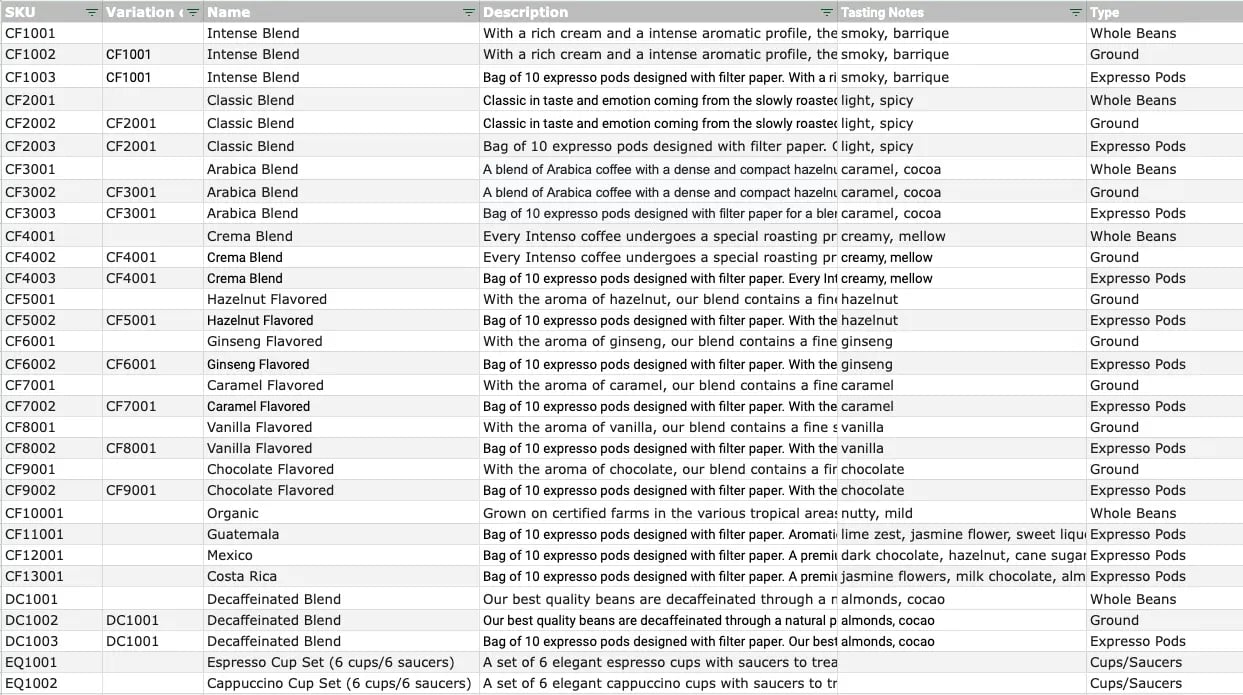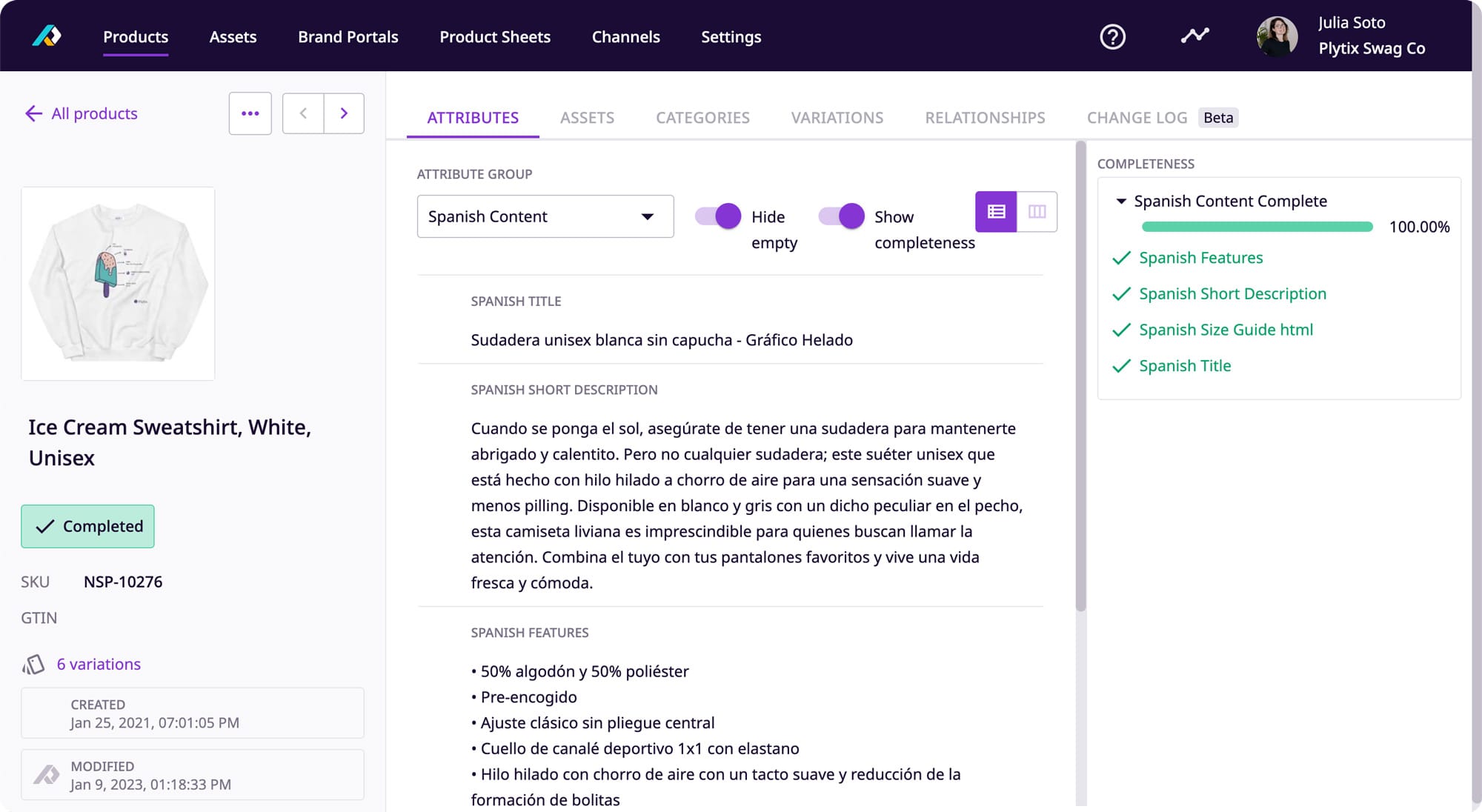
Keep the good stuff coming
Subscribe to our blog newsletter and get monthly content that helps you manage product data smarter.
No spam. Just real value.
Managing product data in spreadsheets is great… when you only have a few products with a limited amount of variations, relationships, and data points. But once you start working with a good amount of products with hundreds or even thousands of data points, managing your product data in spreadsheets doesn’t feel so great anymore.
The thing is, you already know this—that’s why you’re here. You may have hit a bump in the road with managing your product data in spreadsheets and are looking for the secret trick to make it better, or maybe you’re already at the stage of evaluating a new solution but don’t know what that solution is.
Whatever the case may be, I’ll walk you through the challenges of working with product data in spreadsheets, and then we’ll take a look at an automated solution in case you don’t want to put up with spreadsheets anymore. (And if you just want to find a new solution because you already know what the challenges are, then go ahead—skip to the end of the article to find the solution you’ve been looking for.)
Using spreadsheets to manage your product data—what could go wrong?
Spreadsheets are a popular business go-to for a reason. They are versatile, easy to set up, and provide a familiar grid-like interface where you can sum, sort, filter, and even perform basic statistical analyses.
Using spreadsheets is second nature to almost any business person. Most small businesses don't think twice about setting up a spreadsheet to manage data, and honestly, why would they? It’s quick, it's easy, and it seems efficient—at first glance.

The hidden costs of an “inexpensive” solution
However, it’s not that simple. While a spreadsheet program might cost you a few bucks a month per user (or even be free), the hidden costs can add up quickly. According to Gartner, poor data management costs organizations an average of $12.9 million a year.
While you probably won’t lose $12.9 million a year (depending on how big your business is), it’s likely that you’re losing more than you should be from managing your product data in spreadsheets. Errors in product data, lag in updating information, and time spent fixing mistakes are all drains on your valuable resources—your time and money.
7 main challenges with using spreadsheets to manage your product data
Let’s take a look at the biggest challenges that come with product data management in spreadsheets. With this information, you can either try to mitigate these challenges as much as possible or switch to an alternative solution (which we’ll cover right after this).
1. Scattered and inaccurate data
The most obvious but often overlooked challenge is scattered and inaccurate data.
Imagine trying to piece together a puzzle, but the pieces are scattered across different rooms in your house. This is what it feels like to manage product data strewn across various spreadsheets and files. Maybe your product descriptions are in one document, while the pricing details are in another. Your marketing team has their set of files, and your sales team has another. This scattered data becomes a logistical nightmare.
But trying to find the right data isn’t your only problem. You also have data inaccuracy. Inaccuracy in data is like a termite infestation—you might not notice it immediately, but over time, it erodes the structural integrity of your business. When you’re working with spreadsheets, data inaccuracies can come from:
- Manual entry errors
- Lack of validation
- Outdated information
- Formula errors
- Data duplicates
To avoid these inaccuracies and inconsistencies, you'll need to dedicate a lot of time and energy to creating processes and data checks.
2. Sharing data with retail partners is complex and time-consuming
Collaboration with retail partners is important for your market reach and increasing sales. However, getting your product data to your partners isn’t straightforward and simple.
Each retailer will require information in a different format, or they might have unique data fields that they prioritize. Changing your single, massive spreadsheet to meet each partner's demands is a recipe for disaster—or at least, for late nights and lots of coffee.
There are even cases where ecommerce businesses are working with 100+ spreadsheets to manage their data between retailer partners. When you've reached this point of product data complexity, it's definitely time to look for an easier solution.
3. Sending information to multiple sales channels takes too much time
With your multichannel commerce strategy in place, you’ll need to send product data to all your platforms: your website, marketplaces, and even your social media stores.
Each time you add a channel, the complexity multiplies. A single change—a price update, for example—can mean hours of manual editing. It's like trimming a bonsai tree with a lawnmower: clunky, inefficient, and prone to mistakes.
Not only that, but it takes around 20 to 46 minutes to add one product manually to one channel. This means you need to multiply this time by how many products you have AND by how many channels you have. If you have 1,000 products, this could take around 750 hours just to update all your information on one channel. That's a lot of time (and, ultimately, money) wasted.
4. Version control issues: Which version is the right version?
Version control is one of the most frustrating challenges of managing products in a spreadsheet.
In a fast-paced business environment, where multiple team members need to update data, you can easily end up with multiple conflicting versions of the same spreadsheet. You then face the tedious task of merging these documents, sorting out the discrepancies, and figuring out which changes to keep. And every minute you spend on that is a minute not spent on your actual business.
In order to keep this under control, you'll need to set up strict processes in hopes that you won't get your versions messed up. This requires a lot of file organization and a disciplined team to make this happen.
5. Scalability issues: The growing pains of spreadsheets
Spreadsheets have their limits. Once you surpass a certain number of rows, columns, or tabs, performance starts to lag. Loading and saving times become frustrating, and scrolling can feel like you're moving through molasses. Imagine the gut-wrenching feeling when your spreadsheet freezes just as you're about to save hours' worth of updates!
Here are some common issues you'll face with spreadsheets when you're data begins to grow:
- File Size Limitation: As the number of products grows, the spreadsheet files can become large and unmanageable, affecting performance and even leading to crashes.
- Increased Complexity: More products mean more fields, records, and tabs. This increases the complexity of the spreadsheet, making it more difficult to navigate and manage.
- Manual Updating: As you scale, the manual effort required to update product information across various channels and partners increases exponentially, consuming more time and resources.
- Search and Filtering: Spreadsheets are not optimized for advanced search and filtering, which becomes more and more important as the amount of data grows.
The only real way to cope with these issues is by switching to software that can handle the size and has the features to support your needs. Make sure to read to the bottom to see what solution could benefit you.
6. Real-time collaboration is nearly impossible
Most standard spreadsheet programs are not built for multiple users to work simultaneously.
Sure, some advanced cloud-based versions offer real-time collaboration, but these often come with their own set of limitations. Systems like Google Sheets have user limitations, and for each of your spreadsheets, you'll need to update user permissions and make sure everything is set properly so that the right people are working on the right things.
Unfortunately, even if you organize your team well, more often than not, you end up with conflicting versions and wasted time reconciling changes. And your spreadsheets are even more error-prone when you start collaborating with retail partners outside of your organization.
7. Storing digital assets is complex
From your thumbnail image and photo packs to your documentation and PDFs, there are a lot of digital assets you need to store alongside your products. But this isn’t possible in a spreadsheet. This forces you to manage digital assets separately, creating another layer of complexity.
Your team will then need to worry about version controls and organizing your digital media in a way that makes sense with your spreadsheet. Not only that, but you'll also need to create a system that makes sense for all of your teams. Your sales team, ecommerce managers, and marketers will all need access to these files to be able to get their jobs done.
PIM: The best alternative to managing your product data in spreadsheets
(If you are skimming to find the solution I mentioned at the beginning of the article, this is it—Product Information Management (PIM) software.)
Now that we’ve walked through the biggest challenges that come from managing your product data in spreadsheets (from scattered, inaccurate data to complex collaborations with retail partners), let’s take a breath and look at how a Product Information Management (PIM) system can solve these headaches point by point.
Tackling scattered and inaccurate data: PIM systems are designed to be a single, centralized repository for all your product data. Forget about jumping between files—PIM gives you one source of truth, making sure all your data is consistent and accurate.
Simplifying data sharing with retail partners: No more manual exports or conversion headaches. PIM systems allow you to customize data exports to fit the specific requirements of each retail partner, all while automating the sharing process. This simplifies what used to be a complex, time-consuming affair.
Efficient multichannel distribution: One of the standout features of PIM is its ability to seamlessly send data to multiple sales channels with just a few clicks. Say goodbye to the time-consuming task of manually updating each channel.
Solving version control issues: With real-time updates and robust versioning capabilities, PIM systems ensure that everyone is working from the most current data set. No more worries about outdated or conflicting versions.

Scalability for your growing needs: As your product range expands, a PIM system scales with you. Unlike spreadsheets, which become harder to manage as they grow, PIM systems are designed to handle increased data complexity with ease.
Facilitating real-time collaboration: PIM systems offer multi-user environments with customizable permission settings, making real-time collaboration with your team not just possible, but also efficient and secure.
Keeping your products with their digital assets: Storing images, videos, and other digital assets is a breeze with PIM. These systems often come with integrated Digital Asset Management (DAM) features, making it easy to associate assets with specific products or variants.
By addressing these challenges head-on, a PIM system not only solves the problems you're facing today but also prepares your business for future growth and complexities.
Transitioning from spreadsheets to PIM may require an initial investment of time and resources, but the long-term gains in efficiency, accuracy, and ease of use make it a clear winner for any ecommerce business serious about its data management.
The reality of managing your products in spreadsheets
Sure, spreadsheets may feel comfortable, but sometimes you have to admit when it’s time to take on something bigger and better. As you deal with more products, more partners, and more channels, you'll likely find spreadsheets increasingly hard to handle. If you're ready for efficiency, accuracy, and scaling your ecommerce business, looking into a PIM solution should be your next move.
Because, let's face it, no one wants to be the company that lost sales or partnerships because they couldn’t manage their product data. And while you may not need to switch over from spreadsheets to a PIM tool now, make sure you know when the time is right—so that you keep your data clean, your channels updated, and your business thriving.
Frequently Asked Questions
The most common challenges are scattered, inaccurate data, complex and time-consuming sharing with retail partners, time-draining updates across multiple sales channels, version control, scalability limits, difficult real-time collaboration, and complex digital asset storage.
Spreadsheets expose you to the risk of errors, conflicting versions, and security breaches, which can all cost you time, money, and brand reputation.
The more data you add to a spreadsheet, the more sluggish and unwieldy it becomes, affecting your efficiency and increasing the risk of errors.
Most spreadsheets aren’t built for real-time, multi-user collaboration, leading to data conflicts and wasted time.
Spreadsheets often lack advanced security features, making them vulnerable to unauthorized access and data breaches.

Bergen Palmer
Bergen Palmer is a content marketer at Plytix, where she writes all about product information and ecommerce. With a background in ecommerce SaaS and content strategy, she focuses on creating clear, trustworthy content that helps brands work better with their product data.

What if your product data actually worked for you?
We’ll show you how Plytix helps you stop fixing data—and start using it.
Related posts
Keep the good stuff coming
Subscribe to our blog newsletter and get monthly content that helps you manage product data smarter.
No spam. Just real value.







Think others should see this?
Go ahead and share it.